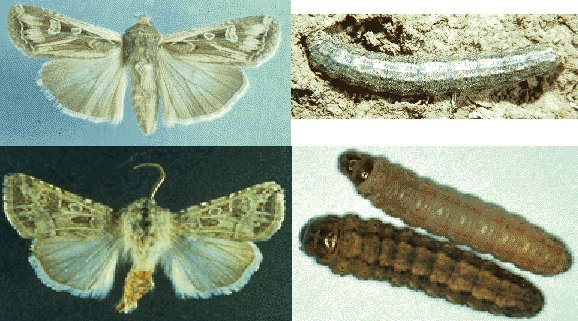|
Cutworm
View more pictures: Bing Images Google Images Yahoo Images Common names: Cutworm Scientific name: Noctuidae Region: This Caterpillar can be found, as various species, throughout North America. Life cycle: This insect produces anywhere from one to five generations each year, depending on the particular species. This insect will overwinter as a pupa or young larva. They burrow several inches down into the soil to pupate and reappear as night flying moths. Eggs are usually laid in the soil but can also be found on weeds, grass, and garden debris. Physical Description: this 1 to 2 inch long caterpillar is gray or brown, is seldom seen during the day, and curls up when disturbed. It is a plump, soft-bodied larvae, usually dull colored and scattered with coarse bristles or hairs. The adult moth is also gray or brown with pale hind wings. It has a wingspan of about 1 to 1 1/2 inches, flies at night, and is attracted to lights. Feeding characteristics: This pest attacks all garden vegetables, especially new seedlings and transplants. You can classify these insects into four groups, depending on the damage they do. Climbing cutworms attack fruits, buds, and leaves. Tunneling cut worms eat at the soil line, cutting off younger plants. All parts of the plant are vulnerable to these insects. Moreover, subterraneans eat out of sight below the soil surface. Controls: They are a good source of food to many predators, such as the Firefly larvae, Fiery Hunter, meadowlarks, blackbirds, toads, moles, and shrews. They also are the prey of the parasitic braconid wasp, Tachinid Flies, and Parasitic Nematodes. In fact, 15 species of bacteria, viruses, fungi, and protozoan help keep this pest in check. You can discourage egg laying by keeping your garden clear of weeds, grass, and debris through the fall. Cultivate during late summer to early fall. Intercropping Sunflowers around the border of the garden will serve as a plant traps. Planting Tansy on the outer edges of the garden will repel the cutworms. If you have time, place leaves of wild onion and garlic in planting holes and tie the leaves around the plants. To prevent serious damage, cultivate lightly around the base of the plants and place a collar of stiff paper or cardboard around each plant, pushing it down one inch into the soil. Toilet paper rolls work great. Another idea is to spread cornmeal around. They enjoy eating it, but cannot digest it and die from indigestion. Molasses is another favorite of the cutworm and can be mixed with hardwood sawdust, wheat bran, and water to make a sticky substance. Spread the substance around the garden and they will crawl around and become paralyzed as the substance hardens on their bodies. For large crops, fields should be plowed or disced as soon as crops are harvested. This will eliminate the grass, which will discourage egg laying. If the field had been in crop or grass the previous September, it should be plowed again in the spring. A flock of chickens can then be used to pluck worms that have been brought to the surface. Hogs are also good at rooting up and eating cutworms, grubs and other insects. Bacillus thuringiensis kills the larvae. Return from Cutworm to Insects A-D Encyclopedia of Garden Insects |
